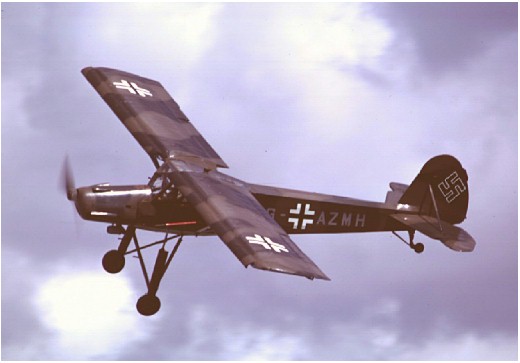
This page contains information about the Fieseler Storch and the various derivatives and replicas thereof I have found.

When I first saw the Fieseler Storch, it struck me as being a ungainly and strange looking aircraft - especially on the ground. Then I discovered its amazing flight characteristics. It has full length fixed wing slats, Fowler-type flaps that increase the wing area by 18 % and ailerons that droop with the flaps when they are extended past 20 degrees. Those long, spindly legs gives the plane the ability to land in arkward places, as they are able to absorb the chock of a hard landing and the wide stance makes for stable landings in rough conditions.
The Storch (Stork) was designed in 1935 by Fieseler, Mewes and Bachem, in response to a contest for a general utility airplane by the RLM. The plane flew for the first time May 24th, 1936. Among its key features was its maneuverability, extremely low stalling speed of 32 mph, and its short field takeoff and landing characteristics. In late 1937, the Storch was accepted by the Luftwaffe and, throughout WWII, was widely used by German military forces for reconnaissance, liaison, ambulance, and other duties and by high ranking officers as personal transports. Between 1937 and 1945, the German Air Force accepted 2,871 Storchs.
Initially the Storch was produced by the Fieseler Werke in Kassel, but from April 1942 on, a production was started at Morane-Saulnier in Puteaux, France. In October 1943 the Fieseler Werke started producing the FW 190 and production of the Storch was shifted to Puteaux. |
|
At the same time, production was commenced at Leichtbau Budweis in the Protectorate of Bohemia and Moravia (better known as Czechoslovakia). Leichtbau Budweis built one Storch in 1943 and 72 the following year, before production was transferred to another Czech firm, Benes-Mraz in Chozen, who produced 64 units for the Germans. |
| Type | Year | Engine | Specifics |
| V1 | 1935/36 | As.10C | Prototype with adjustable metal propeller |
| V2 | 1935/36 | As.10C | Prototype with wooden propeller |
| V3 | 1936 | As.10C | Prototype. Like V2. Testbed for various radio installations |
| V4 | 1936/37 | As.10C | Prototype. Like V3. Skis for landing gear and disposable aux. tank |
| V5 | 1937 | As.10C | Production prototype for A-series |
| A-0 | 1937/38 | As.10C | Pre-production series. Like the V3. 10 were made |
| A-1 | 1938 | As.10C | Like the V5. First version delivered to Luftwaffe. 6 were made |
| B | As.10C | Automatic retractable wing slats. Never entered production | |
| C-0 | 1939 | As.10C | Pre-production. Rear mounted MG 15, Liaison |
| C-1 | 1939/40 | As.10C | First major production version. Like C-0 |
| C-2 | 1940 | As.10C | Reconnaissance and rescue. Enlarged cabin with room for a stretcher |
| C-3 | 1940/41 | As.10C/P | Multipurpose. Some with the more powerful As.10P engine |
| C-3/Trop | 1940/42 | As.10P | Version adapted for tropical / desert conditions. Filtered intakes |
| C-5 | 1941/45 | As.10P | Multi-purpose aircraft with jettisionable aux. tank |
| C-5/Trop | 1941/45 | As.10P | "Tropical" version of C-5 |
| D-0 | 1941/- | As.10C | Pre-production. Ambulance plane with enlarged cabin and larger door |
| D-1 | 1942/45 | As.10P | Production version of D-0 |
| E-0 | 1941/42 | As.10P | Like C-1, but with special tracked landing gear. 10 made |
| F-0 or P | 1942 | As.10P | Counter insurgency ("Polizei") C-3 with machine guns in side windows and bomb-racks/smoke laying |
| U | 1940 | As.10P | Anti-submarine version. C-3 with depth charge |
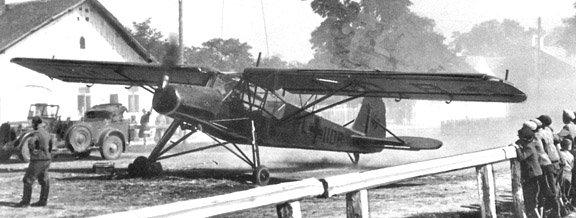
![]()
Videos
Good hi-res video of the Fi-156
Many good videos can be found at YouYube.
![]()
After the war, production of the Storch was continued in both France by Morane-Saulnier, as the MS.500 "Criquet", as well as in Czhechoslovakia by Benes-Mraz, where it was named K-65 "Cap".
The Czech K-65 evolved into the Aero L-60/K-60 "Brigadyr" and later into the L-160/K-160.
The French produced the Criquet in several versions:
In addition to the German/French/Czech productions, the Storch was produced on license in Rumania by ICAR, who produced 80 Fi 156C-3 from 1943.
The Japanese (navy ?) also had their own version of the Storch. When I get the time, I will dig a little further into the latter.
The last production I've heard about, is the Soviet OKA-38 (or Shs), made by Antonov. After being presented with a Storch, Stalin ordered Antonov to start an unlicensed production of the plane. The Argus engine was replaced by a MV-6, which was a copy of a French Renault engine (propably unlicensed as well) and the fuel load was increased, but otherwise the OKA-38 was an exact copy. Nevertheless the STOL capacities were degraded considerably. The production never really got started before it was ended prematurely by the German attack in 1941.
The Storch has been in use throughout large parts of the world. Here is a list of countries using the Storch.
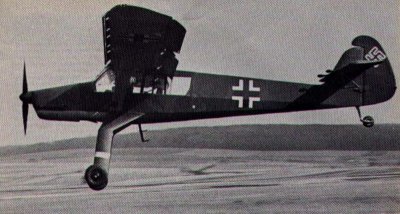 By the time the allies invaded France, the Germans had developed the Fi 256 at the factory in Puteaux. Not much is generally known about the plane, but I do have some information and a few leads to where I can obtain additional information. When I get enough information, I will put up a seperate page with what I have. Basen on the looks of the aircraft, it is quite possible that this is the ancestor of the Dornier Do 27. |
Plans for the original Fieseler Storch are not readily available, but copies of a German WWII Fieseler Storch manual and of some of the original Storch drawings were offered by Gary Oliver at http://www.cnnw.net/~storchman/aircraft/ - the link is now defunct.
I have been busy trying to locate the companies that have produced the Storch:
In an attempt to locate plans for the Criquet, I have contacted Socata, the successors of Morane-Saulnier, but they were unable to help me and passed me on to Muse� de l'Air et de l'Espace in Le Bourget. Clotilde Cucchi at the Museum was most helpful but regretted that they too were unable to help me with plans, although they did have a load of other material about the plane. She did however, give me some possible new leads to follow.
The descendant of the Rumanian ICAR, is Romaero. I contacted the Rumanian embassy in Danmark and was given the address of Romaero, whom I have sent an inquiry December 3rd., 1998. So far, they have not answered.
Also on December 3rd, 1998, I contacted the Czech (Hana Polivkova) and Russian (Nikolay Karsagin) embassies here to see if I could locate anything through them. The Czec people were unable to help, but I have not given up on that angle. No answer from the Russians as of yet, although I have no doubt that they have something stashed in their vast archives that I can use.
As a result of this search, I have managed to locate original plans for the Storch. They cost about 3 USD per page and there are at least 2700 pages, 1200 of which are relevant. That's 3600 USD, which is a bit more than I'm able to set aside for the moment.

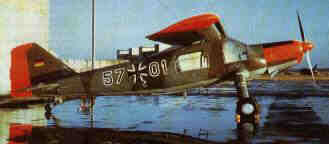
![]()
Replicas:
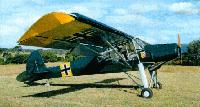
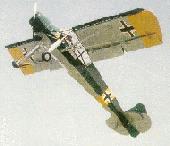 Nestor Slepcev's Slepcev Storch
is the first of the 3/4 replicas I came across. The Slepcev Storch's claim to fame is not how fast it flies, but how slow. It can cruise as slowly as 15 mph. It takes off in 30 feet and needs only 50 feet in which to land. This means that it can fly to and from really small places. It's still available as plans and as a kit, but plans will soon be unavailable, as the plane is being certified. Anyway, the quality of the plans is low. The UK Pilot magazine has a flight test of the Slepcev Storch in the Dec98 issue.
Nestor Slepcev's Slepcev Storch
is the first of the 3/4 replicas I came across. The Slepcev Storch's claim to fame is not how fast it flies, but how slow. It can cruise as slowly as 15 mph. It takes off in 30 feet and needs only 50 feet in which to land. This means that it can fly to and from really small places. It's still available as plans and as a kit, but plans will soon be unavailable, as the plane is being certified. Anyway, the quality of the plans is low. The UK Pilot magazine has a flight test of the Slepcev Storch in the Dec98 issue.
Sky-tek's Carlson Criquet, another 3/4 Storch replica, is only available as a kit and is finally flying. It has folding wings like the original. One note of caution: Get EVERYTHING in writing when dealing with the Carlsons.
Ragwing Aviation has the RW19 Stork, which may evolve into something that resembles a Storch. At the present time the design is still under development. The RW11 will be offered as a kit and may be built with either wooden or metal tube fuselage. Latest news is that plans will become available and that the plane will be offered in two versions - a traditional tandem and a side-by-side. No link available.
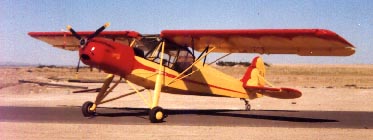 There is also a Storch replica, the PL-9 "Stork", made by Ladislao Pazmany. The plans are of unusually high standard and the entire design has been thoroughly calculated.
There is also a Storch replica, the PL-9 "Stork", made by Ladislao Pazmany. The plans are of unusually high standard and the entire design has been thoroughly calculated.
Sport Aviation has had at least two articles about the Pazmany Stork:
Builders pages:
David VanOverstraeten's Slepcev Storch Project
John, Dave & Loretta's Slepcev Storch Project
Articles:
Flying the Fieseler Fi 156 Storch by Randy Wilson, CAF
The Flight of the Storch by Randy Wilson, CAF
Kai's Luftwaffe Support Aircraft Listing: the mighty Fieseler 156
Reading material:
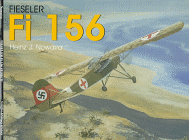 Fieseler Fi 156 Storch
Fieseler Fi 156 Storch
![]() - Heinz J. Nowarra
- Heinz J. Nowarra
I bought Nowarra's book. It seemed a little thin but on re-reading I realized that if you started by knowing nothing about the Storch, it provided a great deal of information. It appears to be the only book in English currently available so, on balance, I would recommend it.
Fieseler Fi 156 Storch im Zweiten Weltkrieg - Piekalkiewicz, Janusz.
Stuttgart: Motorbuch, 1977 192 p. ISBN 3-87943-445-X
Found this book in our airforce library. Very informative. It has background information, stories from real life and loads of pictures.
Fi 156 Storch, Vol 1 - Dariusz Karnas and Pawel Przymusiala
published Warsaw 1998, ISBN 83-7219-019-4
In Polish but has a redeeming factor of photograph captions subtitled in English. About 80 pages with many photos but it's real strength is the colored line drawings. Recommended as an ideal reference work for a modeler.
Ed Buck has compiled a list of Storch-related books and reading material.
Those of us with web sites about Storchs, have joined The Storch Ring, which is a linked list of sites with a common interest in the Storch
 | The Storch
Ring Want to join the Ring ? |
 |
| [Prev 5] [Skip Prev] [Prev] [Next] [Skip Next] [Next 5] [Random] [List Sites] | ||
|---|---|---|
Spam-free discussion list:
For those interested discussing aspects of the Fi 156 Storch and the various derivatives, there is the Storch discussion List. If you want to join, then please type your E-mail address in the box below and then click on the "Join" icon.
Please contact ![]() ping@piteraq.dk if you have further information or corrections.
ping@piteraq.dk if you have further information or corrections.
| Back to previous page | Back to Ping's Homepage |